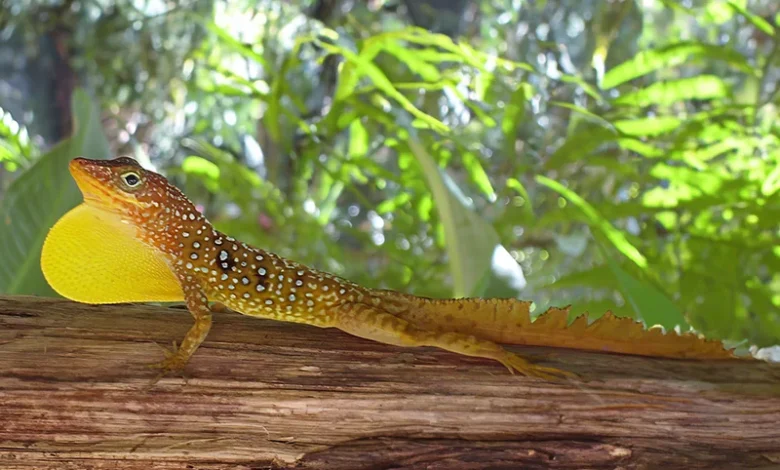Zandoli (Dominican Anole)

The Zandoli (Dominican Anole—Anolis oculatus) is an endemic species of lizard in Dominica. This species is notable for its adaptability across various environments on the island and for exhibiting a wide range of color variations and patterns.
Zandoli’s Physical Characteristics
The Zandoli displays significant morphological diversity, with ground colours ranging from pale tan or yellow to deep green or brown. Markings vary from light-coloured speckling to complex marbled patterns, and some populations feature large black-ringed “eye” spots on their flanks. Adult males typically measure between 61–98 mm (2.4–3.9 in) in snout-vent length, with larger sizes correlating with higher altitudes. Females are generally smaller. Males possess a prominent, extensible throat fan, often bright yellow or orange, used in territorial displays and attracting mates. Females have a rudimentary and less brightly coloured throat fan.
Habitat and Distribution
Endemic to Dominica, the Dominican Anole inhabits diverse environments, from dry coastal woodlands to moist montane forests. Its adaptability allows it to thrive in various ecological zones across the island. The species is divided into four main population groups, also called ecotypes, each adapted to different habitats on the island. These ecotypes are:
- Northern Ecotype – Found in northern Dominica’s dry forests and coastal regions.
- Central Ecotype – Located in the central rainforest regions with high humidity and cooler temperatures.
- Southern Ecotype – Inhabits the drier, more open woodlands of the southern part of the island.
- Eastern Ecotype – Adapted to the wetter and windier coastal environments along Dominica’s eastern coast.
Primarily arboreal, the Dominican Anole spends much of its time in trees but hunts on the ground. Its diet mainly consists of small insects, with occasional consumption of soft-bodied invertebrates and small vertebrates. The species is diurnal, with activity patterns varying based on habitat; in xeric woodlands, it is active throughout the day, peaking at dawn and dusk, while in rainforest populations, it is typically inactive during the middle of the day, remaining at high perches.
Reproduction
The Dominican Anole is long-living and late-maturing compared to other anoles, with breeding typically commencing around two to three months of age. Females lay eggs year-round, with clutches usually consisting of one or occasionally two eggs. Eggs are laid under rocks or leaves on the ground and incubate until hatching.
Conservation Status
Currently, the Dominican Anole is widespread on Dominica. However, it faces potential threats from introduced species. Between 1997 and 2002, Anolis cristatellus, an anole from Puerto Rico, was introduced to Dominica and has begun supplanting the native anole in certain areas, particularly the southwestern coastal region around the capital, Roseau. Within this area, the Dominican Anole has become absent or rare.
Various studies have focused on the Dominican anole’s ecological adaptation, morphological diversity, and behaviour. Research has highlighted the species’ ability to adapt to different environmental conditions, contributing to its survival across diverse habitats on the island.
Cultural Significance
Locally known as the “zandoli,” the Dominican Anole holds cultural significance in Dominica. The Kalinago people considered its presence in their homes a sign of good spirits.
The Dominican Anole is a remarkable example of biodiversity within Dominica, showcasing adaptability and ecological significance. Ongoing research and conservation efforts are essential to ensure the species continues to thrive amid environmental changes and potential threats from introduced species.




